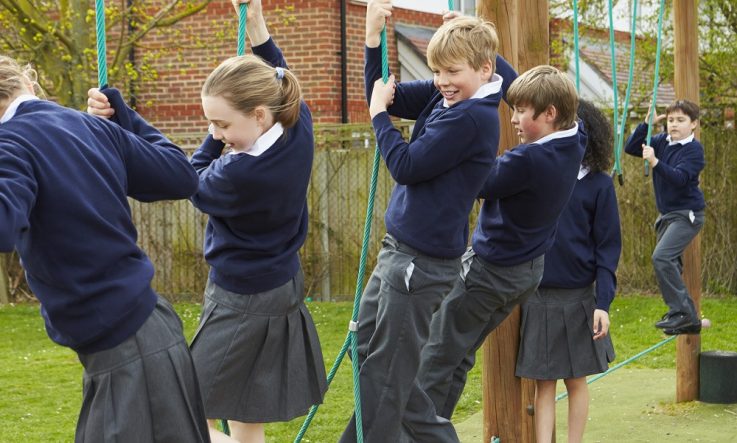A new study involving students in Grades 1 and 2 from three primary schools in Melbourne has assessed the impact of active breaks throughout the school day on the focus and learning of students. The study, Breaking up classroom sitting time with cognitively engaging physical activity: Behavioural and brain responses, was conducted by academics at Deakin University and involved measuring children’s cognitive functions and brain activity. Domains like sitting, standing and stepping patterns; on-task behaviour; and enjoyment of students were also measured.
Teachers at two schools implemented simple and complex active breaks in their classrooms for a period of six weeks. Activities classified as simple active breaks required minimal focus and concentration from children – for example, running on the spot. Complex active breaks involved attention and decision making – for example, games like ‘Simon Says’. The third school involved in the study acted as the control group and did not deliver any active breaks.
In this Q&A, we find out more about the study from the lead author, Postdoctoral Research Fellow Dr Emiliano Mazzoli from the Institute for Physical Activity and Nutrition (IPAN) in the School of Exercise and Nutrition Sciences at Deakin University.
Can you tell us a about yourself and your research team and why this study was important for you to conduct?
I am a Postdoctoral Research Fellow in the Institute for Physical Activity and Nutrition (IPAN) at Deakin University. My main research interests include physical activity, sedentary behaviour, and physical literacy in relation to health and cognitive outcomes, in both typically and non-typically developing children. The research we are discussing today was conducted as part of my PhD, which I also completed at Deakin University. I feel very fortunate to work with such a vibrant and creative group of researchers. My current work focuses on the adaptation of a school-based physical activity/sedentary behaviour program (i.e., Transform-Us!) to cater for the specific needs of youth with disabilities.
I have always been interested in physical activity and sport, which – in my opinion – provide all children with very powerful opportunities for development and learning. Guidelines from the World Health Organization (WHO), recommend that school aged children engage in a minimum of 60 minutes of moderate-to-vigorous physical activity in order to attain the related health benefits. Sadly, only 1 out of 3 Australian children meet these recommendations. As children spend much of their day at schools, implementing appropriately designed physical activity strategies would help them to move more and sit less.
There is growing evidence showing that physical activity not only benefits children’s physical health but can also support their cognitive functioning. So, we wanted to see whether incorporating short active breaks throughout the school day could produce similar benefits in primary school students.
Your objective was to measure the impact of active breaks on cognitive function and brain activity; sitting, standing and stepping patterns; on-task behaviour; and enjoyment. What did you find was the impact on each of these domains, particularly in comparison to the control group?
One of the novel findings in relation to cognitive functions, was that children’s ability to control impulsive responses improved among students whose teachers delivered the active breaks during lessons compared to those in the control group. For brain functioning, the results showed that – compared to control children – children who did complex active breaks required less brain activity to achieve the same level of performance in a test measuring executive functions. This suggests that their cognitive efficiency improved. You can think of this as if a car covered a similar distance while using less fuel.
Confirming the findings from previous studies, children in the active groups improved their focus (on-task behaviour) following the active breaks, compared to those not doing the breaks. Furthermore, students who received active breaks sat less (approximately –14 minutes) and moved more (+ 4 minutes of stepping) during classroom hours, compared to those who did not do breaks. In addition, students generally reported high levels of enjoyment in doing the breaks, regardless of whether they were doing simple or complex activities.
Not everything we measured improved as hypothesised. For example, we did not find significant differences between groups in working memory (i.e., the ability to keep information in memory and manipulate it, like the RAM of a computer). However, none of the results of the study indicated that active breaks could be detrimental for any of the outcomes we measured. This is important because, contrary to the widespread assumption that implementing physical activity across the school day can disrupt children’s attention and learning, our study (in line with previous findings) demonstrates that the opposite might be true.
What kinds of activities were students undertaking as part of these active breaks? Why were these specific activities chosen?
All the active breaks were designed to last between four and five minutes, a duration that other teachers previously reported as feasible in order to incorporate regular breaks in the classroom. Teachers attended 20 minutes of training on how to conduct the activities in their classroom and were provided with a set of seven strategies – different types of strategies depending on the group they were allocated to (simple or complex). We asked them to use these breaks to interrupt students’ longest blocks of sitting twice a day, making sure to regularly rotate between the repertoire we provided to avoid monotony. For example, one break could be conducted between 9:00 am and 11:00 am and another between 11:30 am and 1:00 pm.
Teachers were also given a written description of the activities, suggestions on possible adaptations, an activity log to keep track of the activities performed on each day, and some equipment (i.e., a light-weight ball, visual cards, action prompts, dice, and music). Complex active breaks were meant to be more mentally effortful for participants, compared to simple active breaks. An example of a simple active break was ‘Quick fit!’, an activity that requires children to imitate a simple sequence of movements (e.g., clapping, jumping on the spot, and walking on the spot), that keeps rotating with no variations. The complex version of this activity was the game ‘My Clock is Late!’, the imitation of a coordination sequence with a time delay between teacher and children (i.e., like singing in rounds, but with movement activities instead).
Can you share any possible limitations to this study, and if there are any opportunities for further research?
As mentioned, improvements were not observed in all the outcomes of interest. Perhaps some of the measures we used were not sufficiently sensitive to detect a change. Or it is possible that longer, more frequent, or more intense breaks could generate greater improvements than what we observed.
Another limitation that is important to point out that we measured brain activity using a single channel fNIRS device. The device was consistently placed in correspondence to an area of the brain that shows activity during tasks involving executive functions (i.e., the dorsolateral prefrontal cortex). However, we could only observe one part of the brain. It would be interesting to take the learning from this research and explore what happens in other parts of the brain using a device with multiple channels.
We are always interested in working with schools and teachers to test novel approaches that can support students’ health, wellbeing, and learning, so please contact me if you have something of interest.
If you’d like to share how you’re supporting the health, wellbeing and learning of students in your school community, you can contact Emiliano at e.mazzoli@deakin.edu.au.
How are you addressing sedentary behaviour in your school setting? How could you make room to implement activities like running on the spot, or a game of Simon Says in between lessons? How will you measure what effect this has on the focus of students?



